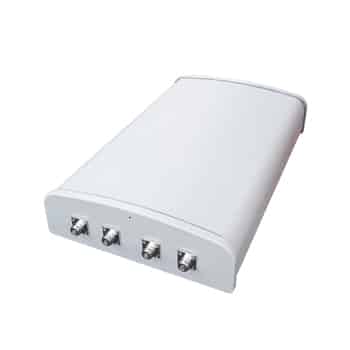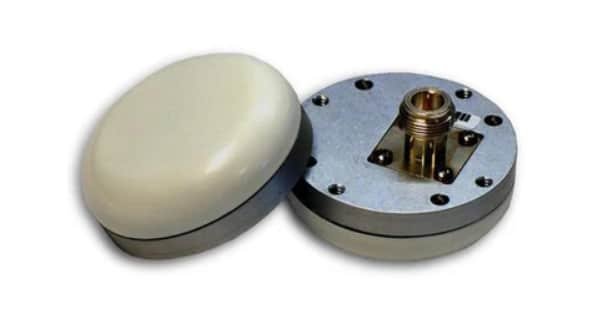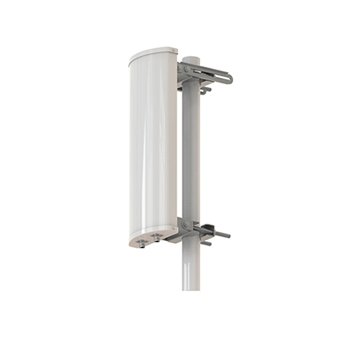In modern communication systems, antennas are essential components that allow radio waves to transmit and receive at various frequencies. Very high frequency (VHF) and ultra-high frequency (UHF) antennas are two popular varieties that meet a range of communication demands.
A UHF antenna is a device intended for receiving and transmitting signals in the UHF band, which is commonly between 300 MHz and 3 GHz. UHF is less effective when passed through nearby obstructions since its frequency waves are shorter. These antennas are used in various applications including,
- Television broadcasting
- Wireless communications
- Mobile phones
- GPS
- Satellite communication
- Radar systems
An antenna made to receive and transmit signals in the Very High Frequency band is known as a VHF antenna. This frequency range covers 30 to 300 MHz and is used, among other things such as,
- Amateur radio
- Commercial radio
- TV broadcasts
- Radio services
There are several different types of VHF antennas, including VHF Yagi, dipole, and ground plane antennas. Each type of antenna has unique directivity and bandwidth characteristics, and they are an essential part of the antenna and necessary for successful communication in the VHF range. VHF waves are better at penetrating and diffracting around obstacles.
In this article, we will discuss both UHF and VHF antennas and characteristics that frequently influence when selecting, like bandwidth, signal penetration, communication range, etc.
Table of Contents
ToggleWhat Do UHF and VHF Mean?
UHF and VHF terms refer to different regions of the radio frequency spectrum. VHF stands for Very High Frequency, covering a range of 30 MHz to 300 MHz, and UHF stands for Ultra High Frequency, which ranges from 300 MHz to 3 GHz. These frequency bands are utilized for a variety of communication applications.
VHF frequencies are often suitable for applications that require longer-range communication, especially in open areas with fewer obstructions, such as rural or outdoor environments. VHF signals can travel long distances with less attenuation, making them ideal for radio broadcasts, and marine communication.
UHF, on the other hand, operates at higher frequencies and offers a wider bandwidth, which makes it better suited for applications that require high data rates. These include Wi-Fi, GPS, cellular communications, and TV broadcasting.
Different Frequency Range
The frequency range is the main difference between UHF and VHF. As we discussed earlier, UHF has a frequency range of 300 MHz to 3 GHz and VHF has a frequency range of 30 MHz to 300 MHz. Compared to VHF, UHF radio waves are smaller. This indicates that a wider reception is produced by smaller waves seen at UHF frequencies. As a result of that, building walls and trees are more likely to be passed by UHF signals.
Longer wavelengths are found in VHF and the range is higher due to low signal attenuation. Despite having a smaller communication range, UHF technology enables larger bandwidth and supports applications that demand faster data transmission speeds via UHF antennas.
The battery life of UHF and VHF is another difference. UHF requires more battery life because of its higher frequency.
Common Usages of VHF antenna
VHF antennas come in a variety of shapes and sizes to correspond with their diverse range of uses. One of them is the dipole antenna, which is used as an indoor VHF antenna and is sometimes referred to as “rabbit ears” because of its look. The flexibility of VHF antennas allows them to be used in many different communication applications due to their exceptional range and ability to pass through natural barriers like buildings.
1. FM Radio and Television
For FM radio broadcasting, the standard frequency range is VHF, which allows for clear audio transmission over extended distances. VHF frequencies are widely used by television stations, specifically for the transmission of analog TV channels.
2. Marine Communications
VHF radios provide reliable connectivity across open water, making them essential for communication between boats and shore stations.
3. Aviation Communication
VHF is used in aircraft communication and air traffic control to ensure consistent and clear communication between pilots and ground.
4. Amateur (Ham) Radio
Amateur radio operators usually use VHF for local communication, particularly in less urban areas as signals can reach far distances.
5. Telemetry and Remote sensing
VHF can be used when long-range signal transmission is required for remote sensing applications like tracking wildlife and environmental monitoring.
Common Usages of UHF Antenna
The UHF band of the electromagnetic spectrum is used in UHF antennas for both receiving and transmitting signals. They have been used in many different contexts. Given below are the most commonly used applications,
1. Public Safety and Emergency Services
UHF antennas are mostly used by public safety officials like fire, police, and EMS to maintain communication over a wide area.
2. Mobile Communication
UHF antennas are used in mobile phones and cellular networks to ensure reliable communication and connectivity.
3. Wireless Communication
Used for wireless communication systems such as Wi-Fi, Bluetooth, and wireless routers. They help transmit and receive data over short distances.
4. Radio
Radio transmissions in the UHF frequency band are received and transmitted using UHF antennas. Walkie-talkies, two-way radios, and other wireless communication devices fall under this category.
5. Television
Over-the-air television broadcasts, particularly those from channels in the UHF band, are received with these antennas.
6. Security
UHF antennas enable wireless transmission of audio and video data and are integrated into security and surveillance systems.
7. RFID (Radio Frequency Identification)
RFID systems, which are frequently used for asset management, access control, and inventory tracking, use UHF antennas to read and write data to RFID tags.
8. Satellite Communication
Satellite communication technologies, such as satellite TV and internet services, require UHF antennas.
Advantages of VHF Antennas
Signal Propagation: The wavelengths of VHF broadcasts are comparatively longer. This increases the distance that VHF transmissions can when there are more open spaces and fewer obstacles like trees and buildings. Lower frequencies are incapable of penetrating solid objects more deeply. So, VHF is a good communication tool for outdoor and rural settings. Since they are composed of lower frequencies, the loss of energy during the transmission is comparatively low.
Coverage Area: VHF is useful for providing coverage in greater geographic areas with fewer radio repeaters or infrastructure because of its longer range. Because of this, it is affordable for wide-area communication needs like forestry services, rural law enforcement, and search and rescue missions.
Low power: VHF devices use less power than UHF devices, which is advantageous for applications that need a long battery life.
Cost: VHF antennas are a better choice for large-scale communication systems since they are often less expensive to produce and maintain.
Advantages of UHF Antennas
High Data Rate: In UHF antennas, we can achieve a higher data rate. This allows UHF to be used in applications that need real-time data.
Compatibility with digital signals: UHF frequencies are widely used by the broadcasting sector for radio and television transmissions. Since UHF television transmissions can carry more information than VHF signals, the quality of the image and sound is higher. In order to ensure clear television signal transmission and reception, many nations have set aside particular UHF channels for television broadcasting.
More channels: UHF frequency bands can accommodate a larger number of channels compared to VHF frequency bands. This allows for more options and variety in terms of available TV channels and radio stations.
Military Applications: The military also uses UHF antenna technology for radar and secure communication systems. Since UHF antennas have a high-frequency range that enables the transmission of more data. It is an ideal tool for military operations that demand secure and reliable communication.
Limitations of VHF Antennas
In VHF, signal quality can be impacted by interferences from other electronic equipment which are at VHF frequencies. Static noise, signal deterioration, and in certain situations even total signal loss can result from this kind of interference.
Larger antennas are required for longer wavelengths, which may not be feasible for portable or small applications. For example, in order to get the best performance, a broadcasting VHF antenna might need to be a few meters long.
VHF signals have trouble passing through buildings in congested urban settings, which could lead to poor coverage in indoor environments. VHF signals experience severe signal attenuation (weakening) when they come into contact with these obstructions. This results in “dead spots” where the signal is too weak to be useful and poor inside reception.
As VHF usually allows lower transmission speeds than UHF, it is not appropriate for high data rate applications. VHF has a lower frequency range than UHF, which reduces the quantity of data that can be sent in a unit of time.
Limitations of UHF Antennas
Shorter Range: In general, when you are using UHF bands, it needs more base stations or repeater stations to cover the same area. This raises the deployment cost and complexity, which limit the usage of UHF antennas in large systems.
Higher Attenuation: Since the energy consumed by high-frequency bands is relatively high, UHF signals are more susceptible to attenuation, which can reduce signal strength. This results in a noticeable loss of transmission.
When line-of-sight is not reached, UHF is less effective for long-distance communication, which restricts its use in some applications. UHF signals typically travel in straight lines, in contrast to VHF signals.
In some applications, UHF devices may need more power to maintain good communication over longer distances, affecting battery life. UHF signals require more power to reach the receiver due to their higher frequency, which results in larger propagation losses.
Antenna Selection Criteria
Before selecting a suitable antenna for your specific application, you may need to consider a few things.
As one of the most important things, it’s important to evaluate on where you are willing to install an antenna. Indoor antennas are available for both VHF and UHF. For example, V-shaped “rabbit ears” are made to detect VHF frequencies. Also, the majority of indoor flat-panel antennas are perfect for picking up UHF transmissions.
However, even if some indoor antennas are said to be able to receive both VHF and UHF signals, it is very doubtful that they will be able to receive low-frequency VHF signals well.
Below are some important criteria to consider when choosing between VHF and UHF antennas:
The decision between VHF and UHF will depend on the nature of the application, such as broadcasting, mobile communication, or aircraft. Long-range communication applications often use VHF, but data-intensive tasks are better served by UHF.
The choice also depends on the environment in which the antenna will be utilized. Because of its greater penetration and range, UHF is better suited for dense urban environments, whereas VHF is better suited for open spaces and rural locations.
VHF is the better choice if the application calls for long-distance communication. For short-range applications that require higher data rates, UHF should be used.
One of the most important factors is the antenna’s size. UHF antennas are more compact and lightweight, so they are a good fit for mobile applications and handheld devices. Due to the large size, VHF antennas are utilized in systems that are fixed or mounted on vehicles.
UHF antennas are recommended for applications like streaming and digital communication that require higher data transmission rates. VHF is a better option for straightforward voice transmission across long distances.
Conclusion
So far, we have discussed the key differences between UHF and VHF that you need to consider when selecting the right antenna for your applications. Due to differences in their frequency ranges, power and limitations, VHF and UHF antennas have specific use cases. While UHF performs well in high-data-rate tasks in urban situations, VHF is best suited for long-range communication and outdoor applications. Making a smart choice can be supported by being aware of the variations in power consumption, bandwidth, signal penetration, size and range.
So, in the end, the surrounding environment in which you are fixing the antenna, application context, and particular communication requirements will determine which antenna is best. The right choice between VHF and UHF will provide you with your application with better performance and reliability in the specified use case, whether it is for mobile communication, public safety, aviation, or marine applications.








